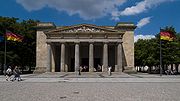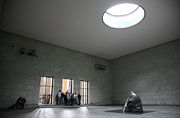
Neue Wache
Encyclopedia



Berlin
Berlin is the capital city of Germany and is one of the 16 states of Germany. With a population of 3.45 million people, Berlin is Germany's largest city. It is the second most populous city proper and the seventh most populous urban area in the European Union...
, the capital of Germany
Germany
Germany , officially the Federal Republic of Germany , is a federal parliamentary republic in Europe. The country consists of 16 states while the capital and largest city is Berlin. Germany covers an area of 357,021 km2 and has a largely temperate seasonal climate...
. It is located on the north side of the Unter den Linden
Unter den Linden
Unter den Linden is a boulevard in the Mitte district of Berlin, the capital of Germany. It is named for its linden trees that line the grassed pedestrian mall between two carriageways....
, a major east-west thoroughfare in the centre of the city. Dating from 1816, the Neue Wache was designed by the architect Karl Friedrich Schinkel
Karl Friedrich Schinkel
Karl Friedrich Schinkel was a Prussian architect, city planner, and painter who also designed furniture and stage sets. Schinkel was one of the most prominent architects of Germany and designed both neoclassical and neogothic buildings.-Biography:Schinkel was born in Neuruppin, Margraviate of...
and is a leading example of German neoclassicism
Neoclassicism
Neoclassicism is the name given to Western movements in the decorative and visual arts, literature, theatre, music, and architecture that draw inspiration from the "classical" art and culture of Ancient Greece or Ancient Rome...
. Originally built as a guardhouse
Guardhouse
A guardhouse is a building used to house personnel and security equipment...
for the troops of the Crown Prince of Prussia
Prussia
Prussia was a German kingdom and historic state originating out of the Duchy of Prussia and the Margraviate of Brandenburg. For centuries, the House of Hohenzollern ruled Prussia, successfully expanding its size by way of an unusually well-organized and effective army. Prussia shaped the history...
, the building has been used as a war memorial since 1931.
King Friedrich Wilhelm III of Prussia ordered the construction of the Neue Wache as a guard house for the nearby Palace of the Crown Prince, to replace the old Artillery Guard House. He commissioned Schinkel, the leading exponent of neoclassicism in architecture, to design the building: this was Schinkel's first major commission in Berlin.
The building has a portico of Doric columns
Doric order
The Doric order was one of the three orders or organizational systems of ancient Greek or classical architecture; the other two canonical orders were the Ionic and the Corinthian.-History:...
. Schinkel wrote of his design: "The plan of this completely exposed building, free on all sides, is approximately the shape of a Roman castrum, thus the four sturdier corner towers and the inner courtyard." The statuary in the pediment
Pediment
A pediment is a classical architectural element consisting of the triangular section found above the horizontal structure , typically supported by columns. The gable end of the pediment is surrounded by the cornice moulding...
of the building is intended as a memorial to Prussia's role in the Napoleonic Wars
Napoleonic Wars
The Napoleonic Wars were a series of wars declared against Napoleon's French Empire by opposing coalitions that ran from 1803 to 1815. As a continuation of the wars sparked by the French Revolution of 1789, they revolutionised European armies and played out on an unprecedented scale, mainly due to...
(known in Germany as the Wars of Liberation). It shows Nike
Nike (mythology)
In Greek mythology, Nike was a goddess who personified victory, also known as the Winged Goddess of Victory. The Roman equivalent was Victoria. Depending upon the time of various myths, she was described as the daughter of Pallas and Styx and the sister of Kratos , Bia , and Zelus...
, the goddess of victory, deciding a battle.
The building served as a royal guard house until the end of World War I
World War I
World War I , which was predominantly called the World War or the Great War from its occurrence until 1939, and the First World War or World War I thereafter, was a major war centred in Europe that began on 28 July 1914 and lasted until 11 November 1918...
and the fall of the German monarchy in 1918. In 1931 the architect Heinrich Tessenow
Heinrich Tessenow
Heinrich Tessenow was a German architect, professor, and urban planner active in the Weimar era.-Biography:...
was commissioned by the state government of Prussia to redesign the building as a memorial for the German war dead. He converted the interior into a memorial hall with an oculus
Oculus
An Oculus, circular window, or rain-hole is a feature of Classical architecture since the 16th century. They are often denoted by their French name, oeil de boeuf, or "bull's-eye". Such circular or oval windows express the presence of a mezzanine on a building's façade without competing for...
(circular skylight). The Neue Wache was then known as the "Memorial for the Fallen of the War." The building was heavily damaged by bombing and artillery during the last months of World War II
World War II
World War II, or the Second World War , was a global conflict lasting from 1939 to 1945, involving most of the world's nations—including all of the great powers—eventually forming two opposing military alliances: the Allies and the Axis...
.
The Unter den Linden was located within the Soviet
Soviet Union
The Soviet Union , officially the Union of Soviet Socialist Republics , was a constitutionally socialist state that existed in Eurasia between 1922 and 1991....
zone of occupation of Berlin, and after 1949 was part of the communist
Communism
Communism is a social, political and economic ideology that aims at the establishment of a classless, moneyless, revolutionary and stateless socialist society structured upon common ownership of the means of production...
German Democratic Republic
German Democratic Republic
The German Democratic Republic , informally called East Germany by West Germany and other countries, was a socialist state established in 1949 in the Soviet zone of occupied Germany, including East Berlin of the Allied-occupied capital city...
. In 1960 the repaired Neue Wache was reopened as a Memorial to the Victims of Fascism and Militarism. In 1969, the 20th anniversary of the GDR, a glass prism structure with an eternal flame
Eternal flame
An eternal flame is a flame or torch that burns day and night for an indefinite period. The flame that burned constantly at Delphi was an archaic feature, "alien to the ordinary Greek temple"....
was placed in center of the hall. The remains of the unknown soldier and of an unknown concentration camp victim from World War II were enshrined in the building.
After German reunification
German reunification
German reunification was the process in 1990 in which the German Democratic Republic joined the Federal Republic of Germany , and when Berlin reunited into a single city, as provided by its then Grundgesetz constitution Article 23. The start of this process is commonly referred by Germans as die...
, the Neue Wache was again rededicated in 1993, as the "Central Memorial of the Federal Republic of Germany for the Victims of War and Tyranny." The GDR memorial piece was removed and replaced by an enlarged version of Käthe Kollwitz
Käthe Kollwitz
Käthe Kollwitz was a German painter, printmaker, and sculptor whose work offered an eloquent and often searing account of the human condition in the first half of the 20th century...
's sculpture Mother with her Dead Son. This sculpture is directly under the oculus, and so is exposed to the rain, snow and cold of the Berlin climate, symbolising the suffering of civilians during World War II.
External links
- "The National Memorial to the Victims of War and Tyranny: From Conflict To Consensus", lecture with handout and bibliography by Harold Marcuse, covers history since 1816.
- Neue Wache travel photos by Galen Fry Singer, of facade, sculpture and inscriptions.

